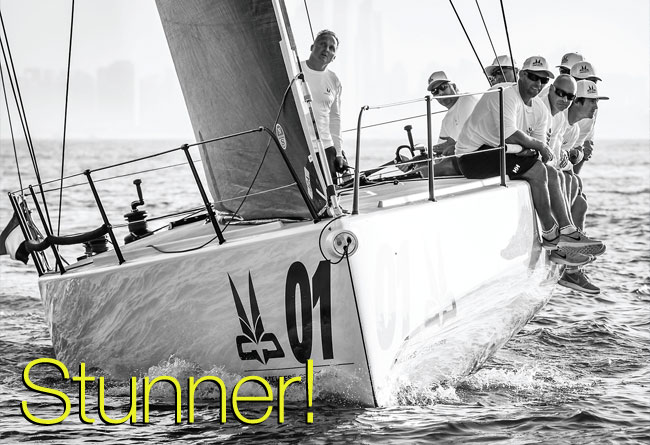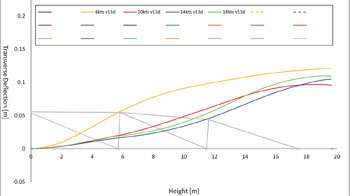

How else to describe Botín’s new Melges 40 canting-keel one-design? North Sails and Southern Spars have been central to the launch of a potential market disrupter
When a new high-performance boat comes on the market the pressure is on to meet the expectations of everyone involved in the project: the designer, builder, class promoters, industry providers, media and – most importantly – potential owners and crews. The higher the performance is, the greater the expectations and lower the acceptable margins for error. New boats of this genre must be fast out of the box with little or no lead time before they can start competing. Everyone wants one, so the first boat built and launched is critical – it must start to deliver on the pre-launch hype right away if a successful new class is to follow.
The new Botín-designed Melges 40 is a perfect example of such a high-profile new design, with the global reputation of Melges on the line. Designer Marcelino Botín has said, ‘Melges is a sailing legend, and this was an opportunity for us to design something very new and different. The design complements the Melges brand, and upholds their top-quality ideals. We proposed a design that adopts best practice and introduces new concepts. The boat creates a new 40ft performance benchmark.’
Builder Max Waimer at Premier Composite Technologies said, ‘For sure the Melges 40 is a new starting point in the sailing world. We share the same passion as Melges and Botín for creating not only an exceptional boat, but a very new, competitive racing experience. We have put every ounce of our expertise into the Melges 40.’
So, against this backdrop, how is North meeting the clear need to have the fastest sails ready from the get-go? The answer is in the process. North Sails has been intimately involved throughout the design development of the Melges 40 to gather the details on the rigging, spar set-up and even the equipment onboard, to advise on solutions that will benefit not only designing fast sails but also contribute to achieving some ambitious project goals. Participation in these formative stages helps in ensuring accuracy in not only detailed sail geometries and shapes, but also in anticipating other key aspects of performance that affect the sails, such as crew work and deck layouts.
With this information the North Design Suite of computational tools can be used to replicate details of how the spar and sails integrate with the platform to deliver the available performance. These tools have been refined repeatedly on a wide variety of boats, ranging from small keelboats to Maxis; the process is well proven and has led to great success on the water.
Not only does this process drive good sail design, but establishing a detailed knowledge base on the ground floor of a new project has other benefits, such as anticipating the content for a tuning guide that is ready at the first launch rather than having to wait for the completion of sail testing. Being a regular sail trimmer on Steve and Heidi Benjamin’s original HPR 40 and now their TP52 Spookie, North Sail designer Chris Williams has a perfect perspective on the design and development process for the new Melges 40. ‘This boat really is unique,’ he says. ‘Besides having lots of sail, the canting keel gives it a righting moment 20 per cent greater than on an HPR 40, so there is some daunting power and speed potential… Modelling the sails to drive all this performance is not just about using variations of existing designs.’
The nitty gritty
‘We started work early with Southern Spars to identify the rig parameters so we could set up the sailplan in DesMan,’ says Williams.
‘On any boat the headstay characteristics are a dominant driver for jib design since they obviously govern luff deflections. For this project we knew there would be no hydraulic headstay ram, so we immediately knew that runner management would be critical. We then looked in detail at the runner set-up: the winch size and how much power it could generate, and the location of the runners and how efficient they would be in transferring loads to the headstay. We also pressed the design team to move the runners as close as possible to centreline so there would be the minimum moment to cause the spar to twist and confuse tuning calculations.

Melges 40 transverse rig deflections are modelled using Southern Spars’ and North Sails’ integrated design software for various wind strengths and mast jack pre-load. The ability to integrate the rig software allows an acceleration of the design spiral, which is particularly helpful in the case of a new one-design, where, for a new class to hit the ground running, all of the suppliers need to be 100% certain of having got things right when the first production example is delivered. Nothing puts raceboat owners off as effectively as the prospect of warranty work when all that they want to do is go racing
‘Once we had recreated the spar’s properties in DesMan, we used Flow and Membrain to model our first test sails on the virtual yacht and start iterating towards greater refinement in the designs. This allows us to give meaningful feedback to the class managers with some early parameters for the One Design rules as well as the build specs for the yacht itself.
‘An example of this is knowing the exact placement and geometry of the spar doubler to ensure that every yacht’s spars will work with every sail in a limited inventory. Modelling mast bend and jib trim through the different ranges of tune and jack loads also allows us to optimise the size and roach profile of the light-air jibs and their batten placement relative to the available space in the foretriangle.’
After this crucial first step the sail designs and their Membrain model data are forwarded to other members of the North design team who, with collective experience of dozens of projects, can further refine their accuracy. For the Melges 40 the North Sails team included Giovanni Cassinari, who is not only a North Sails designer and mainsail trimmer on the SuperSeries 52 Azzurra, but also will be racing on the Melges 40 Inga; Marchino Capitani, another North designer, coach to Azzurra and an Inga team member; and Per Anderson, North Sails’ head of design.
‘I’m sure the sails will be tweaked slightly to make sure that the first set built closely match the ideas and design concepts of the group as a whole,’ says Williams.
‘There are always many ways to skin a cat here. While all of us have our input, the hard part is to make sure the sails are ultimately not designed by committee, so all that input and experience does actually correlate to a fast suit of sails!
‘Finally, another important factor in the project was to work with Melges on new rules to determine a desirable sail inventory, mindful that all of us involved in the project are aware of the need to manage campaign costs. As well as agreeing on a sensible inventory, we also had to give thought to a realistic replacement cycle. For the Melges 40 it was determined that three full-sized jibs were the best solution, given not only the boat’s performance through the range of conditions but also the intended schedule of races and venues.
‘Part of this discussion is driven by the sails’ durability and their ability to retain design shape through an acceptable lifespan. 3Di RAW materials will be used for the new boat’s upwind sails, with a mix of tapes and composition to be determined when the mould shapes and designs are finalised.’
Williams believes that this new and very different one-design with its canting keel and massive sail area will present a steep learning curve for sailors. Yet the proven accuracy of the North Design Suite should ensure the first-generation upwind sails and rig set-up will be at around 95 per cent of their ultimate potential… This is encouraging news for those first few owners who will want to come out of the box with good results and continue to remain fast as the class develops.
Williams reckons that downwind the Melges 40 will meet or even exceed the pace of the latest TP52s. However, the refinement of downwind sails within the allowable 210m2 area will depend upon where each boat will sail and the local conditions: generally light or breezy, flat or choppy seas, and so on. The specific answers to these questions will govern not only the mould shapes chosen, but the location of cross-over points and the selection of materials. Williams is already tending towards the use of polyester/nylon composite rather than all-nylon for gennaker constructions, given the expected blend of high performance along with vigorous accelerations.
‘All told, we expect sails for the Melges 40 to be every bit as successful as what we produce for other competitive one-design classes,’ says Vince Brun, head of North Sails Offshore One Design.
‘They will be fast out of the box due to the quality of the tools along with the talent that we are fortunate to have throughout our team, boosted by a strict collaborative approach – the very same mix that has contributed to the long history of success in this company.’
Click here for more information on North Sails »
We invite you to read on and find out for yourself why Seahorse is the most highly-rated source in the world for anyone who is serious about their racing.
To read on simply SIGN up NOW
Take advantage of our very best subscription offer or order a single copy of this issue of Seahorse.
Online at:
www.seahorse.co.uk/shop and use the code TECH20
Or for iPad simply download the Seahorse App at the iTunes store


